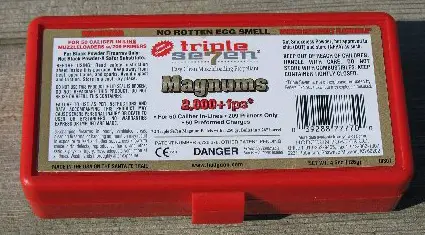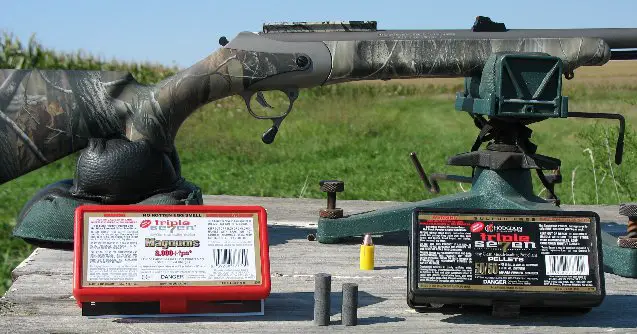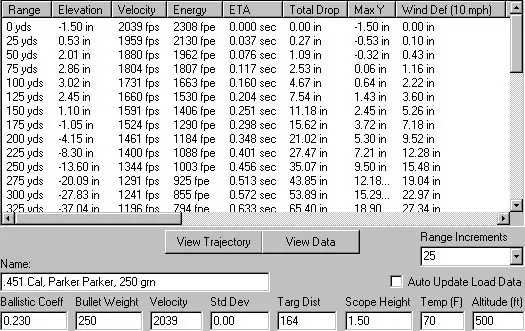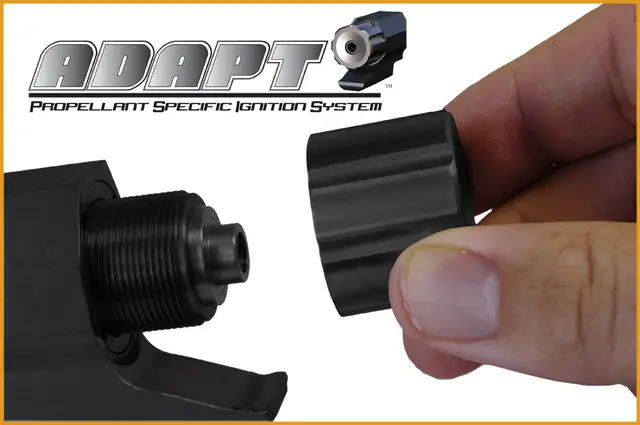


What About Triple Se7en Pellets for Muzzleloaders?

Over the years, there have been many horribly poor attempts to replace blackpowder. Blackpowder itself has properties that have yet to be replaced, though, and is still used in avalanche control, the aggregate industry, and naturally as pan-powder for flintlocks. Good quality blackpowder has always been a very consistent propellant, although a very low energy one. As blackpowder is classified as an explosive, that creates shipment and storage issues.
Ten years ago, I interviewed Doc White, and this is what he had to say at the time:
“Pyrodex P is the propellant of choice for White rifles using #11 or musket caps, not for those using the 209 primer. I prefer Select in that case. I prefer Pyrodex, in general, because it is less hygroscopic than the other substitutes, even though that makes it clean up with somewhat more difficulty.
I prefer P in cap guns because my ballistic experiments show that it ignites more easily, is more uniform to pour as well as to ignite and burn, produces demonstrably more uniform pressure curves with more uniform area "under the curve," produces less variation in velocity and is more accurate (in general) in White rifles than the other subs. (With the exception of "Triple 7," which I have not worked with sufficiently to make a definitive statement.)
Black powder is even better in some categories, especially velocity variation, but is way too dirty to function with my system unless the barrel is cleaned between shots.”
Many of the older blackpowder subs have vanished from the market, for various and sometimes tragic reasons, but there will always be a place for both blackpowder and Pyrodex due to relative ease of ignition. There is no denying the great commercial success of pellets, or “pelletized powder.” Rightly or wrongly, many folks don't want to bother measuring or weighing propellant. And, some well-known hunters prefer pellets as well. From a visit with Tony Knight back in 2006 (http://randywakeman.com/ballltd117.htm), Tony had this to say:
“I really enjoy the convenience of pellets, and Triple Se7en pellets would easily be my top choice.” On one hunt in particular, Tony was in a situation where he had to load his muzzleloader while on his belly. Pellets, that can be loaded into a muzzleloader while the rifle is horizontal, saved the day for Tony in that one particular circumstance.
Triple Se7en loose powder, introduced twelve years ago, raised the bar on what a “100 grain volumetric charge” can produce in terms of velocity from an inline muzzleloader. Triple Se7en pellets were released the following year and by now, most everyone is familiar with them. I've certainly shot enough of them, by now, but the only time I've used them hunting was a boar hunt some years back, with a Knight Disc Elite. The best, most consistent, most generally satisfying pellet combination you can use as far as I'm concerned is two T7 Magnum pellets.
T7 Magnum pellets, sometimes called the “redbox T7,” are claimed to produce about 2000 fps with a 250 grain bullet, from a 28 inch barrel. What I found in my original testing from 2007 is this.

Do the new pellets do as promised?
In a word, yes. The claimed velocities are with “250 grain bullets” and “28 inch barrels.” My testing was with a T/C Triumph, with a usable barrel length significantly less than 28 inches. Shooting at 5 feet from the muzzle with .452 Hornady 250 grain SST’s and Barnes 245 grain Spitfires, my average velocity clocked 2039 feet per second.
To offer a bit of perspective, two “50 grain volumetric” equivalent Pyrodex or standard Triple Se7en pellets more often than not get you into the mid-1800 fps range with 250 grain class bullets. Three Pyrodex pellets (contingent on individual gun, components, and ambient conditions) often get you 2150 – 2200 fps with 250 grain class projectiles. Use of two “Triple Se7en Magnum” pellets gets you right in the middle between two and three Pyrodex (or T7) pellets from a MV perspective. As clearly as I can state it, T7 Magnum pellets will very likely net you more than 100 fps at the muzzle vs. standard two pellet loads and also fall short of standard three pellet loads by a similar amount.
Where the added velocity comes from is obvious: a pair of standard 50/50 T7 pellets weighs about 62 grains on my Lyman electronic scale. A pair of T7 Magnum pellets weighs about 75 grains. We are burning about 20% more stuff with the T7 Magnum pellets; that muzzle velocity goes up should surprise no one. So, I’ll finish by offering up my own feelings on the matter: if I had to hunt with pellets, two Triple Se7en Magnum pellets is what I’d opt for. Hodgdon makes the only pellets that work, anyway.
2039 fps is a formidable load, yet hardly producing unpleasant recoil with 250 grain saboted projectiles. For a look at the basic exterior ballistics with a Parker 250 grain Ballistic Extreme, the chart follows.

There are a few things you can do to eliminate breechplug sticking: crack the breechplug after two or three shots. That will break the bond-line of the fouling, and you'll never stick a breechplug.

Now, there are far better designed breechplugs out there that take care of that issue completely, as in the LHR Redemption that has no internal barrel threads: they are on the outside of the barrel as shown above. Stuck breechplugs are a thing of the past with the LHR Redemption, a superb choice for two Triple Se7en Magnum pellets.
Copyright 2014 by Randy Wakeman. All Rights Reserved.



